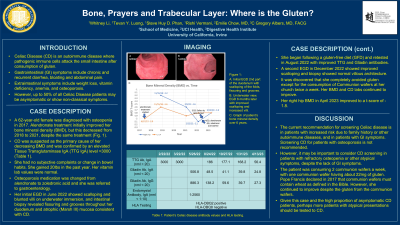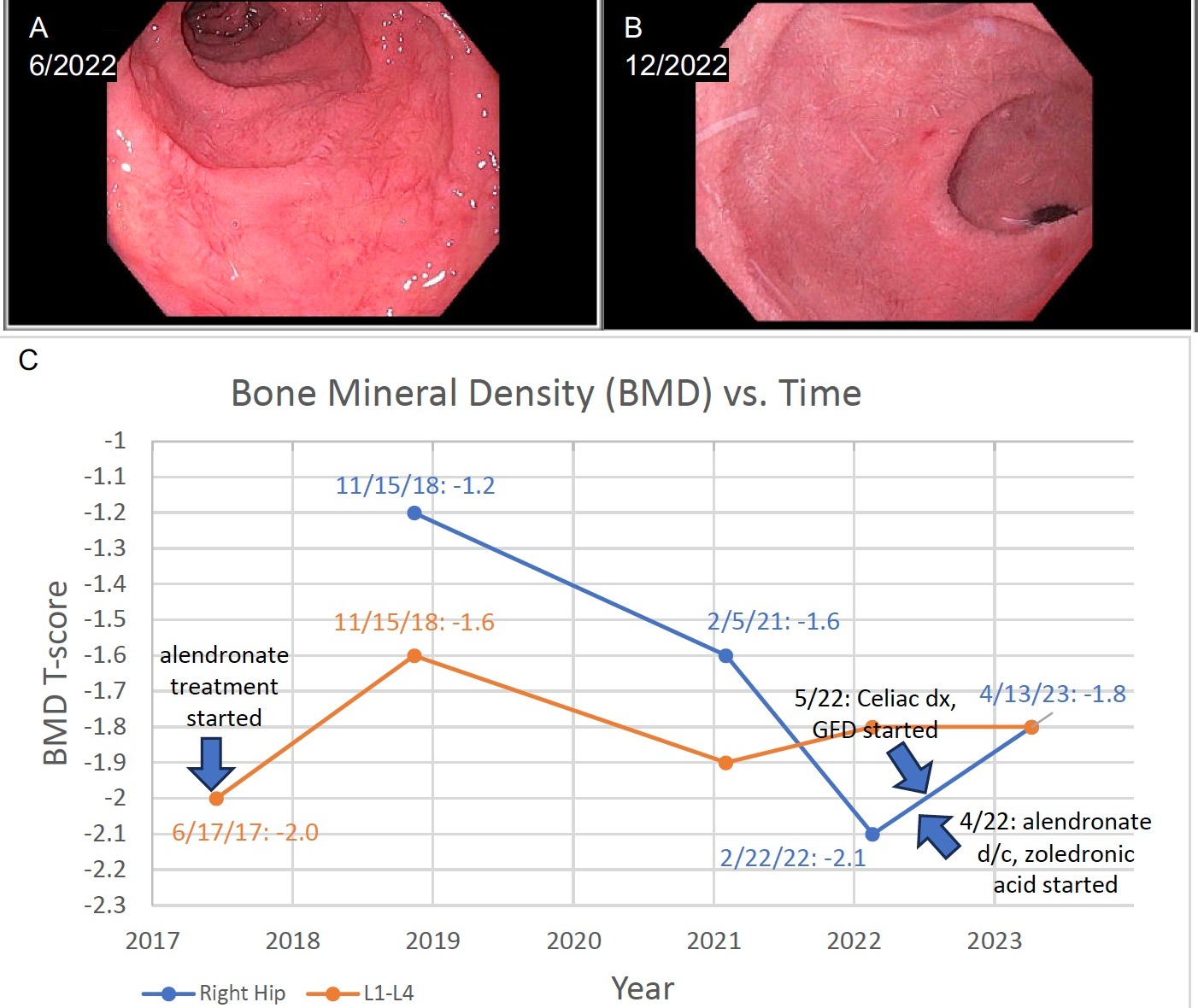Tuesday Poster Session
Category: Small Intestine
P4160 - Bone, Prayers and Trabecular Layer: Where Is the Gluten?
Tuesday, October 24, 2023
10:30 AM - 4:00 PM PT
Location: Exhibit Hall

Has Audio

Whitney Li, BA
UC Irvine School of Medicine
San Jose, CA
Presenting Author(s)
Whitney Li, BA1, Tevan Y.. Luong, BS2, Steve Huy D. Phan, BS, BA3, Rishi Vermani, BS4, Emilie Chow, MD5, C Gregory Albers, MD, FACG6
1UC Irvine School of Medicine, San Jose, CA; 2UC Irvine School of Medicine, Tustin, CA; 3UC Irvine Digestive Health Institute, Irvine, CA; 4UC Irvine School of Medicine, Irvine, CA; 5UC Irvine Health, Orange, CA; 6UC Irvine Digestive Health Institute, Newport Coast, CA
Introduction: While Celiac disease (CD) can occur with classical GI symptoms, more than half of patients with CD do not show classic presentation and may even be asymptomatic. This case report describes an atypical presentation of CD with only refractory osteopenia as the sole symptom.
Case Description/Methods: A 62-year-old female presents with osteopenia diagnosed in 2017. Alendronate treatment improved her L1-L4 bone mineral density (BMD) from a t-score of -2.0 in 2017 to -1.6 in 2018, but despite the same treatment regimen, her right hip BMD reduced from a t-score of -1.2 in 2018 to -2.1 in 2022. CD was suspected as the primary cause of her decreasing BMD and was confirmed by an elevated TTG IgA level of >3000 in February 2022. At this time, she had no subjective complaints or change in bowel habits, and had gained 20lbs in the past year. Her treatment was changed to zoledronic acid and she was referred to GI. Her initial esophagogastroduodenoscopy (EGD) in June 2022 showed scalloping and blunted villi on underwater immersion, and intestinal biopsy revealed fissuring and grooves throughout her duodenum and atrophic (Marsh III) mucosa consistent with CD. She began following a gluten-free diet (GFD) and her antibody count steadily decreased over time (Table 1). A second EGD in December 2022 showed improved scalloping and biopsy showed normal villous architecture. It was discovered that she completely avoided gluten except for the consumption of a Communion wafer at her church twice a week. Her antibody levels most recently dropped to slightly elevated levels in April 2023: 56.4 TTG IgA and 24.8 Gliadin IgA. Her right hip BMD in April 2023 improved to a t-score of -1.8.
Discussion: The current recommendation for CD screening is in patients with risk factors such as family history, autoimmune diseases, or GI symptoms. However, it is important to consider CD screening patients with atypical symptoms, such as refractory osteopenia. This patient only began to show improvement in BMD after beginning a GFD diet, though it is important to note that she changed osteoporosis treatments around the same time she started a GFD. Physicians should be aware of refractory osteopenia as an atypical symptom of CD and perhaps more patients with atypical presentations should be tested to CD. Physicians should also consider each CD patient individually. The added consumptom of Communion wafers has previously been shown to exacerbate CD, but this patient showed improvement in labs and biopsy despite the added gluten burden.

Disclosures:
Whitney Li, BA1, Tevan Y.. Luong, BS2, Steve Huy D. Phan, BS, BA3, Rishi Vermani, BS4, Emilie Chow, MD5, C Gregory Albers, MD, FACG6. P4160 - Bone, Prayers and Trabecular Layer: Where Is the Gluten?, ACG 2023 Annual Scientific Meeting Abstracts. Vancouver, BC, Canada: American College of Gastroenterology.
1UC Irvine School of Medicine, San Jose, CA; 2UC Irvine School of Medicine, Tustin, CA; 3UC Irvine Digestive Health Institute, Irvine, CA; 4UC Irvine School of Medicine, Irvine, CA; 5UC Irvine Health, Orange, CA; 6UC Irvine Digestive Health Institute, Newport Coast, CA
Introduction: While Celiac disease (CD) can occur with classical GI symptoms, more than half of patients with CD do not show classic presentation and may even be asymptomatic. This case report describes an atypical presentation of CD with only refractory osteopenia as the sole symptom.
Case Description/Methods: A 62-year-old female presents with osteopenia diagnosed in 2017. Alendronate treatment improved her L1-L4 bone mineral density (BMD) from a t-score of -2.0 in 2017 to -1.6 in 2018, but despite the same treatment regimen, her right hip BMD reduced from a t-score of -1.2 in 2018 to -2.1 in 2022. CD was suspected as the primary cause of her decreasing BMD and was confirmed by an elevated TTG IgA level of >3000 in February 2022. At this time, she had no subjective complaints or change in bowel habits, and had gained 20lbs in the past year. Her treatment was changed to zoledronic acid and she was referred to GI. Her initial esophagogastroduodenoscopy (EGD) in June 2022 showed scalloping and blunted villi on underwater immersion, and intestinal biopsy revealed fissuring and grooves throughout her duodenum and atrophic (Marsh III) mucosa consistent with CD. She began following a gluten-free diet (GFD) and her antibody count steadily decreased over time (Table 1). A second EGD in December 2022 showed improved scalloping and biopsy showed normal villous architecture. It was discovered that she completely avoided gluten except for the consumption of a Communion wafer at her church twice a week. Her antibody levels most recently dropped to slightly elevated levels in April 2023: 56.4 TTG IgA and 24.8 Gliadin IgA. Her right hip BMD in April 2023 improved to a t-score of -1.8.
Discussion: The current recommendation for CD screening is in patients with risk factors such as family history, autoimmune diseases, or GI symptoms. However, it is important to consider CD screening patients with atypical symptoms, such as refractory osteopenia. This patient only began to show improvement in BMD after beginning a GFD diet, though it is important to note that she changed osteoporosis treatments around the same time she started a GFD. Physicians should be aware of refractory osteopenia as an atypical symptom of CD and perhaps more patients with atypical presentations should be tested to CD. Physicians should also consider each CD patient individually. The added consumptom of Communion wafers has previously been shown to exacerbate CD, but this patient showed improvement in labs and biopsy despite the added gluten burden.

Figure: Figure: A. Initial EGD 2nd part of the duodenum with scalloping of the folds, fissuring and
grooves.
B. Underwater view, EGD 6 months later with resolved scalloping and visualizable villi.
C. Graph of patient’s bone mineral density over 6 years.
grooves.
B. Underwater view, EGD 6 months later with resolved scalloping and visualizable villi.
C. Graph of patient’s bone mineral density over 6 years.
Disclosures:
Whitney Li indicated no relevant financial relationships.
Tevan Luong indicated no relevant financial relationships.
Steve Huy Phan indicated no relevant financial relationships.
Rishi Vermani indicated no relevant financial relationships.
Emilie Chow indicated no relevant financial relationships.
C Gregory Albers: Abbvie – Speakers Bureau. DSI Pharmaceuticals – Speakers Bureau. Nestle Health Sciences – Speakers Bureau. Phathom Pharmaceuticals – Speakers Bureau. Salix Pharmaceuticals – Speakers Bureau.
Whitney Li, BA1, Tevan Y.. Luong, BS2, Steve Huy D. Phan, BS, BA3, Rishi Vermani, BS4, Emilie Chow, MD5, C Gregory Albers, MD, FACG6. P4160 - Bone, Prayers and Trabecular Layer: Where Is the Gluten?, ACG 2023 Annual Scientific Meeting Abstracts. Vancouver, BC, Canada: American College of Gastroenterology.
